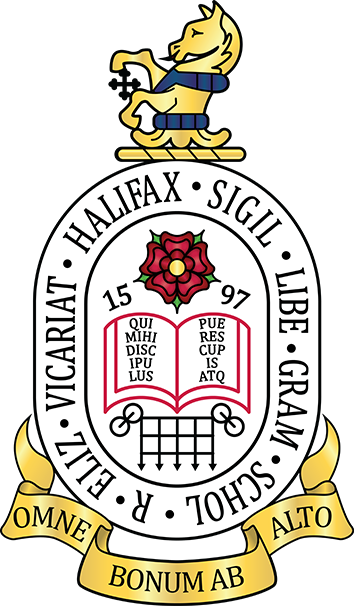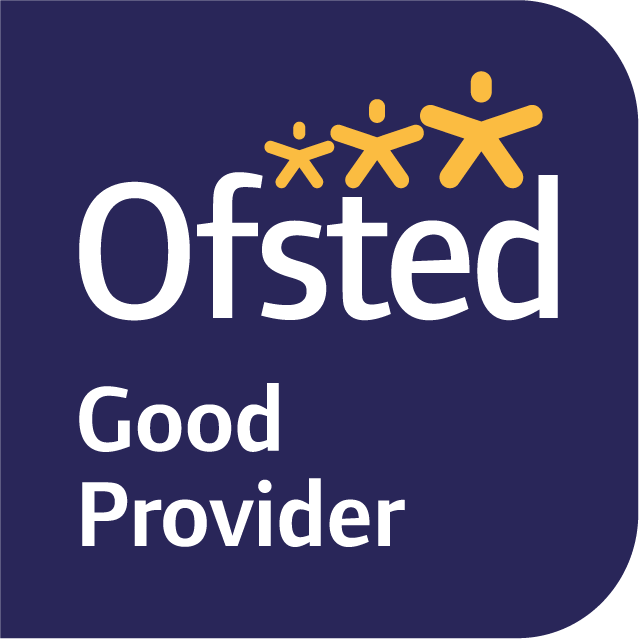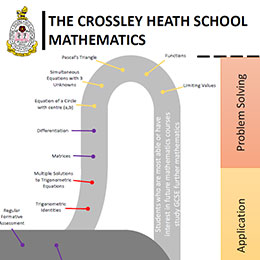
With this intention in mind, we have a varied curriculum that reviews and develops the students’ prior understanding of Number, Geometry, Statistics and Ratio whilst also incorporating new disciplines such as Algebra. These skills are developed through varied lessons which will entail a mixture of traditional teaching methods, grouped and paired work as well as open ended problems in which the students design investigations to make their own personal discoveries. Throughout all of these activities we focus on developing the students’ self-belief in their own mathematical abilities and instilling them with the resilience to believe that they can do something even if they are not quite there yet.
The mathematics department endeavour to maintain and heighten the interest of mathematics that our students possess when they join us. This is achieved through the delivery of our lessons but also through the opportunities we provide outside of the classroom. During Key Stage 3 we incorporate a vast array of learning opportunities to broaden the curriculum, these include a variety of investigations into particularly interesting problems such as using geometric constructions to design their own security plans for protecting an industrial estate. Another popular element of the syllabus is the Year 7 ‘History of Maths’ project in which students are able to take responsibility for their own research and work respectfully within a small team. They are then able to creatively present their findings in a manor suiting their individual skillset. Previous projects have resulted in PowerPoint presentations, posters, cakes and even dramatic renditions of a mathematical story.
Our syllabus is designed to maintain challenge over the course of the five years of study. We spiral through the full spectrum of mathematical disciplines revisiting key areas whilst also introducing increasingly complex topics such as simultaneous equations, trigonometry, conditional probability and surds. Our ultimate goal is that all of our students finishing their GCSE studies are prepared with a deep skillset to continue their mathematical studies at A-level and beyond, whether that is in further study of pure mathematics or applying these skills in the sciences, engineering, medicine or many others areas.
If any student under our care is having any difficulties in their mathematics lessons or understanding a certain topic we have many layers of support available. Our classroom teachers intervene and support during their lessons and adapt work such that it can be more readily accessed. We additionally offer additional classes outside lessons where we feel appropriate and can also assign younger students a sixth form mentor who they can meet with on a regular basis.
Mathematics is popular amongst the students at Crossley Heath, this has led to our department having the largest cohort of A level students of any individual subject in the school. Our teachers are specialists in their areas and all have mathematical related degrees and many years of experience. Students are taught between two teachers such that the specialist topics of statistics and mechanics are taught by those teachers who have a particular specialism in the area. This is increasingly important as the new A-level concentrates more than ever on the wide applications of mathematical modelling.
Mathematics at Key Stage 3
The students are taught for three hours per week within their own form group.
The order in which the topics are covered are
| YEAR 7 | YEAR 8 | YEAR 9 |
|---|---|---|
| Autumn Term | ||
| Number | Number | Sequences |
| Order Of Operations | Factors And Multiples | Arithmetic |
| Types Of Number | Approximation | Geometric |
| Factors And Multiples | Rounding | Quadratic |
| Approximation | Decimals | Ratio And Proportion |
| Rounding | Fractions | Direct Proportion |
| Decimals | Percentages | Compound Measures |
| Fractions | Standard Form | Reverse Percentage |
| Percentages | Algebra | Algebra |
| Standard Form | Algebraic Fractions | Substitution |
| Ratio | Solving Linear Equations | Changing The Subject |
| Sharing Within A Ratio | Changing The Subject | Algebraic Manipulation |
| Proportion Problems | Double Bracket Expansion | Factorisation |
| Unitary Method | Ratio | Length Area Volume |
| Algebra | Speed Distance Time | Circles And Sectors |
| Number Patterns | Density Mass Volume | Quadrilaterals |
| Manipulating Expressions | Statistics | Linear Graphs |
| Solving Linear Equations | Sampling | Drawing Linear Graphs |
| Rearranging Equations | Frequency Polygons | Simultaneous Equations |
| Mean For Grouped Frequency Tables | Parallel And Perpendicular | |
| Correlation And Scatter Graphs | ||
| Geometry | ||
| Area And Perimeter | ||
| Circles | ||
| Volume Of Prisms | ||
| Angle Properties | ||
| Internal And External Angles | ||
| Similarity And Congruency | ||
| Spring Term | ||
| Geometry | Algebra | Right Angles |
| Perimeter And Area Of Triangles And Quadrilaterals | Straight Line Graphs | Pythagoras |
| Area And Circumference Of Circles | Parallel And Perpendicular Lines | Trigonometry |
| Surface Area And Volume Of Prisms | Graphical Solutions Of Simultaneous Equations | Angles |
| Angle Facts | Elimination Method For Simultaneous Equations | Polygons |
| Angles In Parallel Lines | Geometry | Parallel Lines |
| Angles In Polygons | Pythagoras | Scale Drawings |
| Constructions With Compasses | Trigonometry (SOHCAHTOA) | Statistics |
| Isometric Drawing | Probability | Averages |
| Plans And Elevations | Sample Space Diagrams | Statistical Diagrams |
| Transformations | Relative Frequency | Collecting Data |
| Reflective And Rotational Symmetry | Tree Diagrams | Frequency Polygons |
| Planes Of Symmetry | Algebra | Cumulative Frequency |
| Probability | Quadratic Factorisation | Box Plots |
| Simple Probability | Quadratic Equations | Histograms |
| Multiple Events | Difference Of Two Square | Probability |
| Mutually Exclusive Vents | Relative Frequency | |
| Experimental Probability | Mutual Exclusivity | |
| Algebra | Venn Diagrams | |
| Drawing Graphs Of Linear Equations | Powers | |
| Gradient Intercept Method | Index Laws | |
| Standard Form | ||
| Fractional and Negative Indices | ||
| Summer Term | ||
| Algebra | Geometry | Surds |
| Revision Of Key Topics From Term 1 | Volume Of Prisms | Simplifying Surds |
| Application To Geometrical Problems | Volume Of Pyramids And Cones | Four Operations |
| Application To Investigations | Volume Of Spheres | Expanding Brackets |
| Simultaneous Equations | Surface Area Of 3D Shapes | Rationalising the Denominator |
| Recognising Graphs | Loci | Equations |
| Statistics | Vectors | Linear Equations |
| Averages | Circle Theorems | Quadratic Equations |
| Surveys | Algebra | Simultaneous Equations |
| Bar Charts | Sequences Revision | Elimination |
| Scatter Diagrams | Changing The Subject | Substitution |
| Pie Charts | Solving Inequalities | Inequalities |
| Geometry | Drawing Inequalities On A Number Line | Linear |
| Construction Revision | Recognising Graphs Of Curves | Quadratic |
| Loci | Number | Graphical Methods |
| Pythagoras | Bounds | Transformations |
| Probability | Recurring Decimals | Circle Theorems |
| Venn Diagrams | Fractional And Negative Indices | Volume |
| History of Maths Project | Surds | Prisms And Cylinders |
| Statistics | Pyramids | |
| Cumulative Frequency | Cones | |
| Box Plots | Spheres | |
| Probability | ||
| Venn Diagrams | ||
GCSE Curriculum: Key Stage 4
The students are taught for four hours per week within streamed groups which will all take the AQA higher mathematics exam in Year 11. The syllabus is taught in full by the end of Year 10 and then in Year 11 lessons will focus on applying skills to a range of exam contexts such as interleaving different skills with problem solving situations. The students in year 11 are provided with additional intervention groups where appropriate to develop their fluency skills so that they are able to fully access the content in lessons.
The order in which the topics are covered are:
- Triangles
- Sine And Cosine Rule
- Area Of Any Triangle
- Exact Trigonometric Values
- Algebraic Fractions
- Functions
- Composite Functions
- Inverse Functions
- Recurring Decimals
- Powers and Surds
- Recap of Year 9
- Rationalising the Denominator
- Construction and Loci
- Proof
- Algebraic Proofs
- Geometric Proofs
- Congruence & Similarity
- Direct and Inverse Proportion
- Quadratics
- Sketching Graphs
- Quadratic Simultaneous Equations
- Conditional Probability
- Iteration
- Curved Graphs
- Recognising Curves
- Transformations
- Trigonometric Graphs
- Travel Graphs
- Tangents
- Estimating the Area under curves
- Bounds
GCSE Further Mathematics
In addition to the GCSE in Mathematics, our department makes an additional GCSE in ‘Further Mathematics’ available to all students. This qualification is designed to deepen students’ understanding of high level concepts from the Mathematics GCSE to ensure they achieve their highest potential but also gives those studying it an introduction to certain A-level topics. The additional topics covered in this course are
- Algebra
- Domain And Range
- Factor Theorem
- Piecewise Functions
- Limiting Values As A Sequence Tends To Infinity
- Equations of Circles With Any Centre
- Simultaneous Equations with Three Unknowns
- Calculus
- Differentiating Polynomials
- Finding The Equation Of A Tangent And Normal
- Finding Stationary Points
- Checking The Nature Of Stationary Points
- Sketching Curves
- Matrices
- Operations With Matrices
- The Identity Matrix
- Transformations
- Geometry
- Transformations Of Functions
- Solving Trigonometric Equations To Give Multiple Solutions
- Trigonometric Identities
- Exact Trigonometric Values
A Level Curriculum
We offer two courses at A-level – Mathematics and Further Mathematics.
Mathematics
The students will be in lessons for 9 hours per fortnight which are usually divided between two teachers. The students will continue developing their understanding of Number, Algebra, Geometry and Statistics whilst also introducing important new topics such as Calculus and Mechanics
At the end of the two year course they will sit the Edexcel examinations. This consists of three 2 hour examinations, two pure papers and one paper that is 50% Statistics and 50% Mechanics.
Our department offers multiple levels of support to ensure the students reach their highest potential. We run weekly support sessions that specifically target different ability levels including an A* club for the most able in the cohort as well having developed our own series of ‘Facts and Basics’ booklets which have been highly rated by students of all ability ranges. These booklets cover all of the ‘easy marks’ and areas in which students of all ranges should be attaining 100% as well as providing straight forward examples of every topic which contain nothing designed to catch them out. On the run up to the examinations we provided revision days in the holidays and during study leave to give each student every opportunity to reach their full potential.
Further Mathematics
Students who take this course must also take the A-level in Mathematics.
The students will be in 8 hours of additional lessons per fortnight and this allows the students to broaden the range of their mathematical understanding. There is more scope for tailoring this course to the future mathematical needs of the class of students. On top of the two compulsory 90-minute pure mathematics examinations we are able to choose two of eight other papers which further study Pure, Statistics, Mechanics and Decision Mathematics. Due to the cohort that we usually have comprising of Computer Scientists and Physicists, we usually choose Decision Mathematics 1 and Further Mechanics 1 as the options.
The Enriched Curriculum
There are of course other important aspects to developing a student’s mathematical understanding and enjoyment outside of classwork and examinations. The UKMT mathematics challenges are very popular amongst Crossley Heath students. These challenges are available to students in Years 7-13 and test students’ ability to decipher more open ended puzzle style questions. In all of the available year groups we take a selected group of students to compete in a regional team challenge, some of which have previously progressed to the national finals. We attend the annual ‘Maths Inspiration’ events with students in Years 10 – 12 which feature a range of guest speakers who work in mathematical fields as well as professionally lecture globally. For the post-16 students we additionally run a trip to Leeds University during the summer term in Year 12 in which selected students tackle problem solving questions. These questions are both enjoyable as well intellectually stimulating and are designed to increase the students’ skillset when tackling the harder problem solving questions that are in the new A-level examinations.


